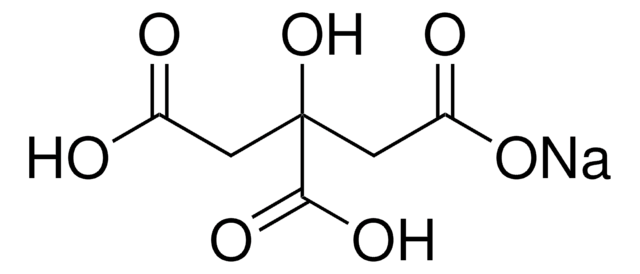567446
Citrate de sodium tribasique dihydrate
Molecular Biology Grade
Synonyme(s) :
Acide citrique trisodium salt dihydrate, Citrate trisodique dihydrate
About This Item
Produits recommandés
Qualité
Molecular Biology
Niveau de qualité
Pureté
≥99% (titration)
Forme
crystalline solid
Fabricant/nom de marque
Calbiochem®
Conditions de stockage
OK to freeze
Couleur
white
pKa (20 °C)
6.40
Pf
>300 °C (lit.)
Solubilité
water: 100 mg/mL
Traces de cations
heavy metals: ≤0.001%
heavy metals (as Pb): ≤0.001%
Absorption
≤0.015 at 260 nm
≤0.015 at 280 nm
Activité étrangère
DNases, proteases, RNases, none detected
Conditions d'expédition
ambient
Température de stockage
15-25°C
Chaîne SMILES
O.O.[Na+].[Na+].[Na+].OC(CC([O-])=O)(CC([O-])=O)C([O-])=O
InChI
1S/C6H8O7.3Na.2H2O/c7-3(8)1-6(13,5(11)12)2-4(9)10;;;;;/h13H,1-2H2,(H,7,8)(H,9,10)(H,11,12);;;;2*1H2/q;3*+1;;/p-3
Clé InChI
NLJMYIDDQXHKNR-UHFFFAOYSA-K
Vous recherchez des produits similaires ? Visite Guide de comparaison des produits
Description générale
Application
- Study on the preparation of ascorbic acid reduced ultrafine copper powders in the presence of different protectants and the properties of copper powders based on methionine protection.: This research utilizes sodium citrate dihydrate as a protective agent in the synthesis of ultrafine copper powders, enhancing their stability and properties for potential applications in catalysis and electronics (Ke X et al., 2024).
- Optimization of micro-QuEChERS extraction coupled with gas chromatography-mass spectrometry for the fast determination of phthalic acid esters in mussel samples.: Sodium citrate dihydrate is employed in the extraction process for the detection of phthalic acid esters in mussels, demonstrating its effectiveness in analytical chemistry and environmental monitoring (Carro N et al., 2023).
- New butanolide derivatives from the marine derived fungus Aspergillus terreus GZU-31-1 by chemical epigenetic manipulation.: This study highlights the role of sodium citrate dihydrate in the isolation and characterization of new bioactive compounds from marine fungi, contributing to natural product research and drug discovery (Zhou Y et al., 2024).
- PEGylated Gold Nanoparticles Grafted with N-Acetyl-L-Cysteine for Polymer Modification.: Sodium citrate dihydrate is used as a reducing agent in the synthesis of PEGylated gold nanoparticles, which are then applied for polymer modification, highlighting its applications in nanotechnology and materials science (Fajstavr D et al., 2021).
- Characterization of sodium tripolyphosphate and sodium citrate dehydrate residues on surfaces.: This research focuses on the characterization of residues of sodium citrate dihydrate on surfaces, providing insights into its applications in surface chemistry and industrial cleaning processes (Gurses MS et al., 2018).
Avertissement
Reconstitution
Informations légales
Code de la classe de stockage
11 - Combustible Solids
Classe de danger pour l'eau (WGK)
WGK 1
Point d'éclair (°F)
Not applicable
Point d'éclair (°C)
Not applicable
Certificats d'analyse (COA)
Recherchez un Certificats d'analyse (COA) en saisissant le numéro de lot du produit. Les numéros de lot figurent sur l'étiquette du produit après les mots "Lot" ou "Batch".
Déjà en possession de ce produit ?
Retrouvez la documentation relative aux produits que vous avez récemment achetés dans la Bibliothèque de documents.
Les clients ont également consulté
Notre équipe de scientifiques dispose d'une expérience dans tous les secteurs de la recherche, notamment en sciences de la vie, science des matériaux, synthèse chimique, chromatographie, analyse et dans de nombreux autres domaines..
Contacter notre Service technique


